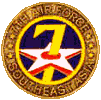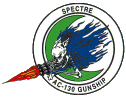|
Paul Faris Gilbert
Captain
16TH SPECIAL OPS SQDN, 8TH TAC FTR WING, 7TH AF United States Air Force Plainview, Texas September 19, 1941 to June 18, 1972 PAUL F GILBERT is on the Wall at Panel W1, Line 44 |
   |
  |
|
Paul had been my father's roommate at Ubon RTAFB, Thailand. Paul's plane went down one night when a heat seeking missile (SA-7) hit an inboard engine (I think #3). It was this incident that really messed my father, Lang Metzger, up. He was exhausted from flying night after night and they'd given him the night off. Afterwards, Lang kept thinking that if he was there that night he might have saved Paul and the crew. There were 16 guys on the Paul's aircraft, and some were Lang's crew. After they got hit, Paul held the plane level to give people a chance to bail out. It was still level with people diving off the ramp, trailing flames and with every gun for miles firing at it, when it exploded. Lang thought 5 people got out. Three got back. Lang never forgave himself for not being with Paul on this flight. Paul will always be thought of as a hero. I just want him to have a place here with his brothers.
From his rooommate's daughter, |
A Note from The Virtual WallThe 16th Special Operations Squadron, based at Ubon, Thailand, flew the AC-130 SPECTRE gunship. On the night of 18 June 1972, an AC-130A Spectre gunship (tail number 55-0043, call sign "Spectre 11") launched on a night armed reconnaissance mission to attack NVA along the Ho Chi Minh Trail. The crew consisted of 15 men:
At least three men were thrown clear of the aircraft as it broke up and parachuted safely to the ground. SAR efforts were begun at daybreak and Capt. Bocher, 2nd Lt. Reid and SSgt. Patterson were successfully picked up. The three men are reported to have stated, during debrief, that they saw at least one additional parachute. Although the SAR efforts continued for six days, no trace of the rest of the crew was found. No ground search was possible due to the intense enemy presence in the region. When the formal search was terminated, the remaining 12 crewmen were declared Missing in Action. At this point, matters become less certain. There were reports that some of the Spectre 11 crewmen had been captured, but in a 12 November 1993 letter Major General Thomas H. Needham, then Commander, Joint Task Force - Full Accounting, states that "4. In June 1993, a joint investigation team located two witnesses who produced dog tags relating to two individuals (Harrison, Wilson) involved in this incident, along with three flight helmets. The team photographed the dog tags and helmets which were retained by the witnesses. The team traveled to the crash site and conducted a survey. During the survey, the team recovered portions of a flight suit and survival vest. The team also observed the tail assembly from a C-130 aircraft.The US government holds that the remains recovered and other evidence is sufficient evidence that the twelve men died in the crash. Three of the crewmen were identified individually from the recovered remains - Maj. Gerald F. Ayers, Capt. Mark Danielson, and Senior Master Sgt. Jacob Mercer. On 17 November 1994, a group burial of the co-mingled remains of the AC-130A Spectre gunship crew was held at Arlington National Cemetery. |
| Contact Us | © Copyright 1997-2019 www.VirtualWall.org, Ltd ®(TM) | Last update 08/15/2019. |